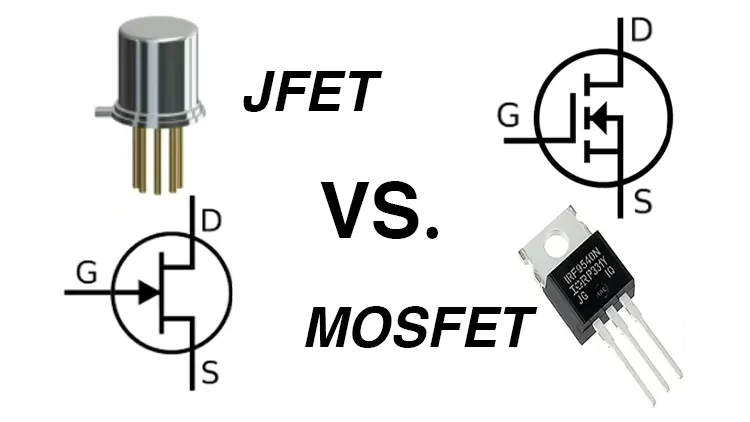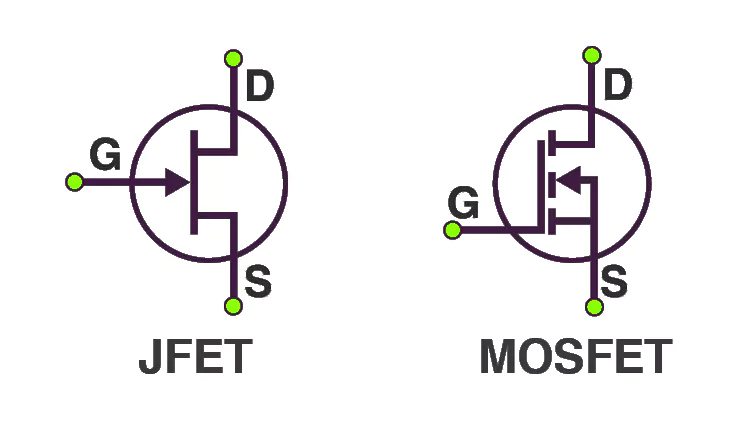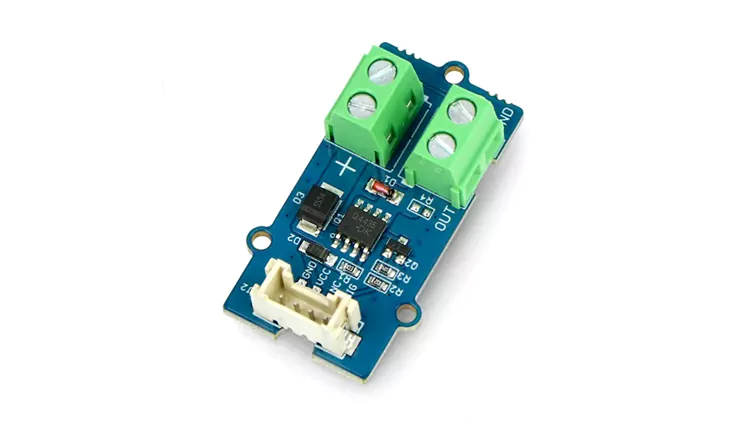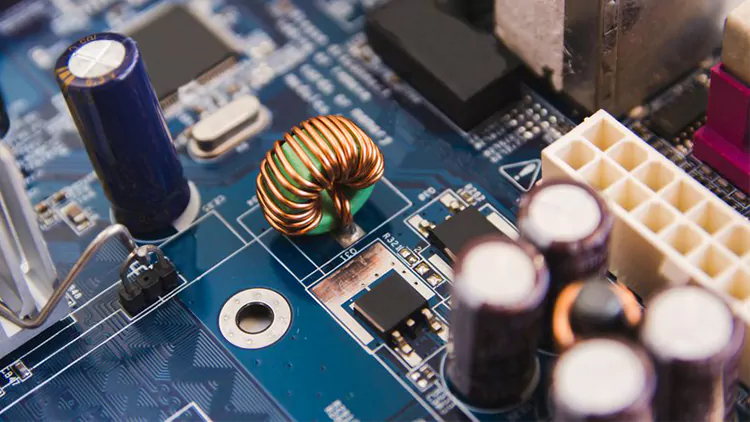Field-Effect Transistors (FETs) are essential components in the world of electronics, playing a crucial role in amplifying and switching signals. Among the various types of FETs, the Junction Field-Effect Transistor (JFET) and the Metal-Oxide-Semiconductor Field-Effect Transistor (MOSFET) stand out due to their distinct characteristics and applications.
The article compares JFET vs MOSFET transistors, detailing their differences, advantages, and applications in amplifiers, guitar pedals, and high-power electronics.
What is JFET and MOSFET?

JFET (Junction Field-Effect Transistor)
JFETs are one of the simplest types of FETs, characterized by their use of a junction (p-n junction) to control the flow of current. In a JFET, the current flows through a channel between the source and drain terminals, and this flow is regulated by the voltage applied to the gate terminal. JFETs come in two main types: n-channel and p-channel, based on the type of charge carriers that flow through the channel.
MOSFET (Metal-Oxide-Semiconductor Field-Effect Transistor)
MOSFETs, on the other hand, utilize an insulated gate (made of metal oxide) to control the current flow through a semiconductor channel. This gate insulation provides MOSFETs with high input impedance, making them highly efficient and widely used in various electronic applications. MOSFETs are also classified into n-channel and p-channel types, depending on the charge carriers.
What is the Difference Between JFET and MOSFET?

The fundamental difference between JFETs and MOSFETs lies in their construction and operation. While both are used for similar purposes, their unique characteristics make them suitable for different applications.
1. JFETs vs MOSFETs: Structure and Gate Control:
JFET: The gate of a JFET is a reverse-biased p-n junction, and the current flow is controlled by the depletion region formed around this junction.
MOSFET: The gate of a MOSFET is insulated from the channel by a thin layer of metal oxide, allowing for a higher input impedance and better control over the current flow.
2. JFET vs MOSFET: Input Impedance:
JFET: JFETs have a moderate input impedance.
MOSFET: MOSFETs have a very high input impedance due to the insulated gate.
3. MOSFET vs JFET Operational Efficiency:
JFET: JFETs are less efficient compared to MOSFETs, particularly at high frequencies.
MOSFET: MOSFETs are highly efficient and perform well at high frequencies, making them suitable for high-speed applications.
4. MOSFETs vs JFETs Voltage Control:
JFET: The voltage applied to the gate in a JFET negatively controls the channel conductivity.
MOSFET: The voltage applied to the gate in a MOSFET can either enhance or deplete the channel conductivity, providing more flexibility in circuit design.
| Feature | JFET | MOSFET |
| Structure | p-n junction gate | Insulated gate (metal oxide) |
| Input Impedance | Moderate | Very high |
| Control Type | The voltage applied to the gate can enhance or deplete the channel | The voltage applied to gate can enhance or deplete the channel |
| Efficiency | Lower, especially at high frequencies | High, suitable for high-speed applications |
| Power Consumption | Lower | Higher |
| Frequency Response | Lower | Higher |
| Thermal Stability | Good | Moderate |
| Application Complexity | Simpler | More complex |
Applications of JFET and MOSFET
Application of JFET

JFETs are commonly used in low-noise applications due to their high input impedance and low-level signal amplification capabilities. They are ideal for use in:
- Analog Switches: JFETs serve as analog switches in various electronic circuits.
- Buffer Amplifiers: Their high input impedance makes JFETs suitable for buffer amplifiers in audio equipment.
- Voltage-Controlled Resistors: JFETs are employed in circuits where variable resistance is required.
- Low-Frequency Amplifiers: JFETs are used in amplifiers for low-frequency signals, such as in audio systems and instrumentation.
Application of MOSFET

MOSFETs are widely used in a variety of electronic applications due to their high efficiency and fast switching capabilities. Common applications include:
- Power Supplies: MOSFETs are essential components in switch-mode power supplies (SMPS) for their efficiency.
- Motor Drives: Used in controlling and driving electric motors in industrial and automotive applications.
- RF Amplifiers: Their high-frequency performance makes MOSFETs suitable for RF amplification.
- Digital Circuits: MOSFETs are integral in digital circuits, including microprocessors and memory devices.
- Audio Amplifiers: High-power audio amplification systems often utilize MOSFETs for their superior performance.
Advantages of MOSFET over JFET

High Input Impedance: The insulated gate of MOSFETs provides a very high input impedance, which minimizes the loading effect on the preceding stage of the circuit.
Higher Efficiency: MOSFETs are more efficient, especially at higher frequencies, making them ideal for high-speed switching applications.
Greater Control: The gate voltage in MOSFETs can both enhance and deplete the channel conductivity, offering greater flexibility in design and functionality.
Low Power Consumption: While MOSFETs consume more power in switching compared to JFETs, their low on-resistance reduces power dissipation during operation.
JFET vs MOSFET Amplifier
JFET Amplifiers: JFET amplifiers are known for their high input impedance and good linearity, making them suitable for low-noise and low-frequency applications. They are often used in audio amplifiers, buffering stages, and low-frequency signal amplification.
MOSFET Amplifiers: MOSFET amplifiers, with their high efficiency and high input impedance, are preferred for high-frequency and high-power applications. They are commonly found in RF amplifiers, power amplifiers, and switching circuits.
Comparison:
- Noise Performance: JFET amplifiers typically exhibit lower noise levels, making them suitable for audio applications.
- Frequency Response: MOSFET amplifiers provide better performance at higher frequencies, making them ideal for RF and microwave applications.
- Power Handling: MOSFET amplifiers can handle higher power levels, which is beneficial for power amplification purposes.
MOSFET vs JFET Overdrive
Overdrive pedals are designed to push the guitar signal into a subtle distortion, adding warmth and character to the sound. The choice between MOSFET and JFET overdrive circuits depends on the desired tonal characteristics.
JFET Overdrive: JFET overdrive circuits provide a smooth, tube-like overdrive with a natural breakup and warm harmonics. They are preferred for vintage and bluesy tones.
MOSFET Overdrive: MOSFET overdrive circuits offer a more precise and dynamic overdrive, with tighter bass response and higher headroom. They are suitable for modern rock and metal genres.
Comparison:
- Warmth and Harmonics: JFETs excel in creating a warm, harmonically rich overdrive.
- Precision and Headroom: MOSFETs provide a more precise and controlled overdrive with higher headroom.
- Application: JFET overdrives are ideal for vintage and classic rock tones, while MOSFET overdrives are better suited for modern, high-gain applications.
SiC JFET vs MOSFET
Silicon Carbide (SiC) technology has brought significant advancements in the performance of transistors, particularly in high-power and high-temperature applications. Both SiC JFETs and SiC MOSFETs offer unique benefits.
SiC JFETs: SiC JFETs provide low on-resistance, high current capability, and excellent thermal stability. They are suitable for high-power applications where efficiency and reliability are crucial.
SiC MOSFETs: SiC MOSFETs offer even higher efficiency and faster switching speeds compared to their silicon counterparts. They are ideal for high-frequency, high-power applications, such as power supplies and motor drives.
Comparison:
- On-Resistance: SiC JFETs have lower on-resistance compared to traditional silicon JFETs.
- Switching Speed: SiC MOSFETs exhibit faster switching speeds, which is beneficial for high-frequency applications.
- Thermal Performance: Both SiC JFETs and MOSFETs offer excellent thermal stability, but SiC MOSFETs are generally preferred for their superior performance in high-temperature environments.
- Application Suitability: SiC JFETs are suitable for applications requiring low on-resistance and high current handling, while SiC MOSFETs are better for high-speed switching and high-efficiency power conversion.
JFET vs MOSFET Guitar Pedals
Guitar pedals utilize various types of transistors to shape the sound and tone of the guitar signal. Both JFETs and MOSFETs are popular choices for different reasons.
JFET Guitar Pedals: JFETs are favored in guitar pedals for their smooth, tube-like distortion and warm sound. They are often used in overdrive and distortion pedals to emulate the characteristics of vacuum tubes.
MOSFET Guitar Pedals: MOSFETs are chosen for their crisp, dynamic response and higher gain. They are used in pedals where a more aggressive, high-gain distortion is desired.
Comparison:
- Sound Quality: JFETs offer a warmer, more natural distortion, while MOSFETs provide a brighter, more aggressive tone.
- Gain Levels: MOSFETs can achieve higher gain levels, which is beneficial for metal and high-gain genres.
- Versatility: Both types of transistors offer unique characteristics, allowing pedal designers to choose based on the desired sound profile.
Conclusion
JFETs and MOSFETs each have their unique characteristics and applications in the field of electronics. Understanding the differences between these two types of transistors, their advantages, and their specific uses in amplifiers, guitar pedals, and high-power applications allows for informed decision-making in circuit design and component selection.
Whether you prioritize the warm, tube-like distortion of JFETs or the high efficiency and dynamic response of MOSFETs, both types of transistors play a vital role in shaping the performance and sound of electronic devices.